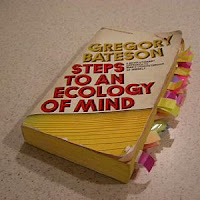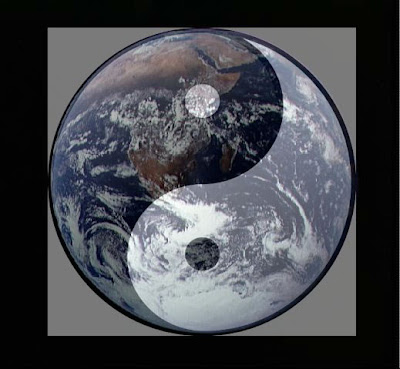
In the observation and description of complex systems, which make up all living systems and the interactions between them and the environment, above the level 3 - biology - the beliefs and the "world view" of the subject observer/descriptor start to become important and must be explicit in the observation/description that it does. In particular, the movement cybernetics-second-cybernetics-post-cybernetics is essential to specify their own Epistemology, giving rise to an epistemology of complexity. Traditionally, epistemology is the branch of philosophy that deals with conditions under which you can have scientific knowledge and methods to achieve this knowledge, as suggested by the term, which is a contraction of the Greek words episteme ("knowledge, science
") and logos (speech). In general, as such, is included as a part, if not completely identified with thephilosophy of science, which concern with the assumptions, foundations, methods and implications of science.
In the Anglo-Saxon culture the concept of epistemology is used as a synonym for gnoseology or
theory of knowledge, the discipline that deals with the study of knowledge in general. In the definition of Bateson:
EPISTEMOLOGY: A combination of a branch of science with a branch of philosophy. As a science, epistemology studies how particular organisms or aggregates of organisms "know, think and decide." As philosophy, epistemology studies the limits required, and other characteristics of the processes of knowledge, thought and decision.
and in his words:
"Warren McCulloch used to say that those who claim to have direct knowledge, that is not to have an epistemology, is actually a bad epistemology [...]"
"So I call the epistemology as the science that studies the process of knowing, the interaction between the capacity to respond to differences on the one hand and, secondly, the material world in which these differences have their origin in some way.
...
There is a more traditional definition, under which the epistemology is simply the philosophical study of how to learn. I prefer my definition - as in fact you know - because the creature fits into the larger whole, ... and because by my definition Epistemology is definitely identified with the study of phenomena that occur on an interface and a branch of natural history. [...]"
The need to make explicit its epistemology - that is our own assumptions about the world - depends on the level of observation. If a microbiologist observes the development of a nutrient broth does not seem necessary, but already at the level of an entomologist observing an ant colony or at the level of etology, the study of animal behavior in its natural environment, it becomes necessary, not to mention interactions with fellow human beings, as in the setting of psychotherapy.
"The vision of the world - that is latent and epistemology in the "unconscious" - generated by all of these ideas is exceeded by three different perspectives: a) From the pragmatic point of view it is clear that these assumptions and their corollaries lead to 'greed, a monstrous excess growth, war, tyranny and pollution. In this sense, "our" assumptions prove false every day, and what the students make some account.
b) In terms of "intellectual", these premises are obsolete as systems theory, cybernetics, holistic medicine, ecology and psychology of "Gestalt" manifestly best offer ways of understanding the world of biology and behavior.
c) As a basis for the "religion" became the premise that I mentioned
"Clearly unacceptable and therefore obsolete" about a century ago. After the advent of Darwinian evolution, it was expressed quite clearly by thinkers such as Samuel Butler and Prince Kropotkin. But already in the eighteenth century William Blake understood that the philosophy of Locke and Newton could only generate "dark satanic mills."
The Platonic thesis of the book is precisely that epistemology is an indivisible and integrated metascienza the object of which is the world's evolution of thought, adaptation, embryology and genetics: the science of the mind in the broadest sense of term.
Compare these phenomena (compare thought with the evolution and epigenesis with both) is the "search mode" epistemology of science that
It began to seem outdated and that the ideas are still rooted on epistemology, especially on the human, were a reflection of a physical fight and outdated in a curious way with the little we know, or so it seems, on living things. It was as if we thought that the members of the species 'man' materials were totally unique and totally against the backdrop of a living universe generic (instead, only) and spiritual (rather than, material).
In what is presented in this book, the place of the hierarchical structure of the Great Chain of Being will be taken from the hierarchical structure of thought, which Bertrand Russell called "hierarchy of logical types, and seek to propose a sacred unity of the biosphere it contains fewer errors epistemological versions of it that have been submitted by the various historical religions. The important thing is that, right or wrong, this epistemology is "explicit". This will criticize it just as explicit."

Bateson states that the fundamental unit of evolution is not the organism or species, but the organism
-plus-environment (ie, mind). He calls this theory cybernetic epistemology:
«the individual mind is immanent but not only in body, it is also immanent in channels and messages outside the body, and there is a larger mind of which the individual mind is only a subsystem. This larger mind is comparable to God, and is perhaps what some people mean by 'God', but it is still immanent in the total interconnected social system and planetary ecology».
(Form, substance and difference)
The term epistemology was used by Bateson in many ways:
1 epistemology as a theory of knowledge.
2. epistemology as a paradigm.
3. epistemology as a biological cosmology.
4. epistemology as a science.
5. epistemology as a structure of the character.
from: P. F. Dell Understanding Bateson and Maturana: Toward a biological foun- dation for the social sciences
Journal of Marital and Family Therapy, Vol. 11, n. 1,1985.
«In the natural history of the human being, ontology and epistemology can not be separated. His convictions (usually unconscious) about the world around him (ie, its ontological premises) will determine the way he see it (ie, his epistemological premises) and acting, and this way of perceiving and acting (ie its epistemological premises) will determine his beliefs about the nature of the world (ie, its ontological assumptions). The living man is thus trapped in a web of ontological and epistemological premises. It is awkward to always refer to epistemology and ontology together, but is wrong to think that they can be separated in the natural history ... Therefore in this paper I will employ the single term "epistemology" to describe both aspects of the plot of assumptions that govern the adaptation (and maladaptation) to the human and physical environment ».








































